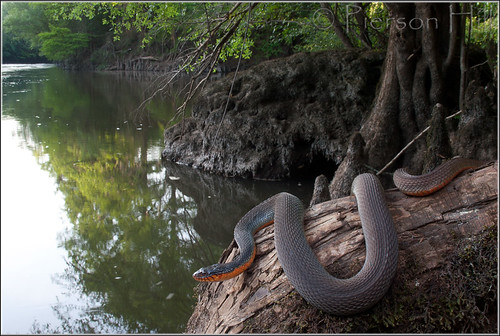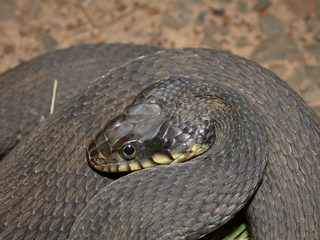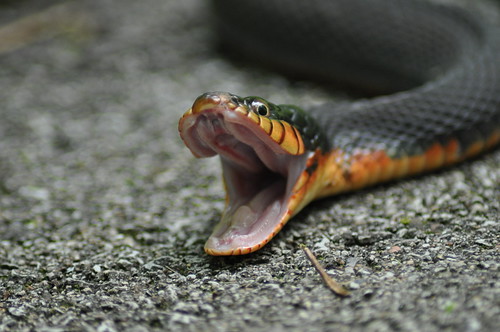Post by Ceratodromeus on Feb 18, 2016 10:05:36 GMT 5

Scientific classification
Kingdom: Animalia
Phylum: Chordata
Subphylum: Vertebrata
Class: Reptilia
Order: Squamata
Suborder: Serpentes
Family: Colubridae
Subfamily: Natricinae
Genus: Nerodia
Species: N. erythrogaster
Subspecies
- N.e. transversa - blotched water snake
- N.e. alta - Plainbelly water snake
- N.e. bogerti - Bogert's water snake
- N.e. erythrogaster -redbelly water snake
- N.e. flavigaster - yellowbelly water snake
- N.e. neglecta - copperbelly water snake
analysis of this species' mitochondrial dna conducted in 2010{1} have concluded that there is not sufficient enough divergence in recognized subspecies to elevate them to full species status.
Description
This is a stout bodied natricine, with a dark dorsal coloration. Blotching can be found on the sides of the animal, and is typically lighter then the dorsal coloration in adults and more pronounced in juvenile animals. The ventral(bottom)side of the animal can range from a bright yellow to a dark red, depending on the subspecies. Females tend to be slightly larger overall, measuring anywhere from 0.84-1.2m(2.7ft-3.9ft) in total body length, with most measuring just over 1m(3.28ft). Males measure 0.71-1m(2.3-3.3ft), measuring around 0.9m in total body length(2.9ft) on average{2}. The largest recorded animal was a female N.e.erytrogaster taken from Alabama, measuring 1.63m(5.3ft) in total length{2}.

Geographic range and habitat
This is a sucessful, wide ranging species, ranging from the south eastern United States(e.g. Northwestern Florida, Georgia, and south Carolina), west
into Mexico(from localities such as Coahuila, Nuevo Leon, Tamulipas, Durango, and Zacatecas). These snakes spend most of their time in the waters of large rivers, wetlands, floodplains, and will even utilize flooded suburban areas{2}. In the colder months, these snakes will retire to Hibernacula, in which they will spend several months. This can consist of interspecific hibernaculum useage, such as denning with other species of snakes, or using beaver and/or muskrat lodges{3}.

Dietary habits
This species spends most of its time in large bodies of water, and therefore the vast majority of prey taken is aquatic based life. Observations on the plain bellied water snake have documented it to be an active forager, swimming on the surface looking for fish, frogs, toads, salamanders, and even crawfish. Animals recorded being taken as prey include fish of the banded pygmy sunfish (Elassoma zonatum), orange spotted sunfish(Lepomis humilis) young large mouth bass(Micropterus salmoides), Central stone rollers(Campostoma anomalum), Hornyhead chub(Nocomis biguttatus), Southern redbelly dace(Phoxinus erytrogaster) Margined madtom(Noturus insignis), Brindled madtom(Noturus miurus), mole salamanders(Ambystoma sp.), Two toed amphiumas(Amphiuma means) American toads(Bufo americanus), American green tree frogs(Hyla cincerea) American bullfrogs(Lithobates catesbianus), green frogs(Rana clamitans), and northern leopard frogs(Rana pipiens). They are not constricting snakes, nor are they venomous, so when they come across an animal they want to eat they will grab it, and swallow it alive.

Reproduction
Not a lot of reproduction data is available on these snakes; courtship and copulation has only been observed a handful of times. What has been documented seems to indicate copulation occurs in April, and the young are born anywhere from July to September. Like other members of the Nerodia genus, the plain bellied water snake gives birth to live young. Litter size is extremely variable, with as little as 2 or as many as 55 being attributed to this species, with most falling closer to 17{2}. Upon birth, neonates measure 185-328mm(7.2-12.9in) in total body length, and will weigh anywhere between 4-6g(0.14-0.2oz).

References
{1} Makowsky, Robert, et al. "Phylogeographic analysis and environmental niche modeling of the plain-bellied watersnake (Nerodia erythrogaster) reveals low levels of genetic and ecological differentiation." Molecular Phylogenetics and Evolution 55.3 (2010): 985-995.
{2} Gibbons,J, Dorcas, Michael "North American Watersnakes: A Natural History".
{3} Kingsbury, Bruce A., and Christopher J. Coppola. "Hibernacula of the copperbelly water snake (Nerodia erythrogaster neglecta) in southern Indiana and Kentucky." Journal of Herpetology 34.2 (2000): 294-298.


